with复合结构讲解及练习分析
- 格式:ppt
- 大小:2.00 MB
- 文档页数:31

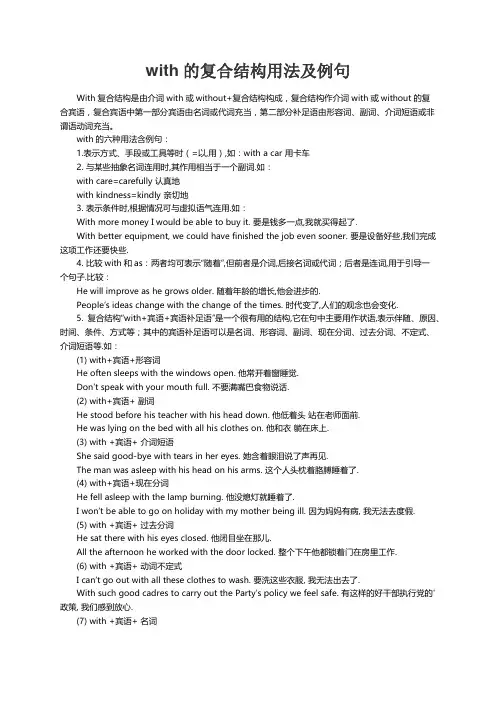
with的复合结构用法及例句With复合结构是由介词with或without+复合结构构成,复合结构作介词with或without的复合宾语,复合宾语中第一部分宾语由名词或代词充当,第二部分补足语由形容词、副词、介词短语或非谓语动词充当。
with的六种用法含例句:1.表示方式、手段或工具等时(=以,用),如:with a car 用卡车2. 与某些抽象名词连用时,其作用相当于一个副词.如:with care=carefully 认真地with kindness=kindly 亲切地3. 表示条件时,根据情况可与虚拟语气连用.如:With more money I would be able to buy it. 要是钱多一点,我就买得起了.With better equipment, we could have finished the job even sooner. 要是设备好些,我们完成这项工作还要快些.4. 比较with和as:两者均可表示“随着”,但前者是介词,后接名词或代词;后者是连词,用于引导一个句子.比较:He will improve as he grows older. 随着年龄的增长,他会进步的.People’s ideas change with the change of the times. 时代变了,人们的观念也会变化.5. 复合结构“with+宾语+宾语补足语”是一个很有用的结构,它在句中主要用作状语,表示伴随、原因、时间、条件、方式等;其中的宾语补足语可以是名词、形容词、副词、现在分词、过去分词、不定式、介词短语等.如:(1) with+宾语+形容词He often sleeps with the windows open. 他常开着窗睡觉.Don’t speak with your mouth full. 不要满嘴巴食物说话.(2) with+宾语+ 副词He stood before his teacher with his head down. 他低着头站在老师面前.He was lying on the bed with all his clothes on. 他和衣躺在床上.(3) with +宾语+ 介词短语She said good-bye with tears in her eyes. 她含着眼泪说了声再见.The man was asleep with his head on his arms. 这个人头枕着胳膊睡着了.(4) with+宾语+现在分词He fell asleep with the lamp burning. 他没熄灯就睡着了.I won’t be able to go on holiday with my mother being ill. 因为妈妈有病, 我无法去度假.(5) with +宾语+ 过去分词He sat there with his eyes closed. 他闭目坐在那儿.All the afternoon he worked with the door locked. 整个下午他都锁着门在房里工作.(6) with +宾语+ 动词不定式I can’t go out with all these clothes to wash. 要洗这些衣服, 我无法出去了.With such good cadres to carry out the Party’s policy we feel safe. 有这样的好干部执行党的'政策, 我们感到放心.(7) with +宾语+ 名词He died with his daughter yet a schoolgirl. 他去世时,女儿还是个小学生.With复合结构:一、with或without+名词/代词+形容词例句:1.I like to sleep with the windows open.我喜欢把窗户开着睡觉。
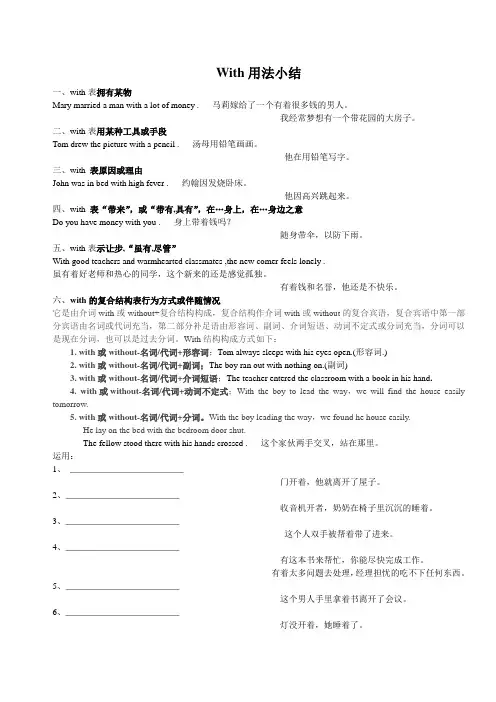
With用法小结一、with表拥有某物Mary married a man with a lot of money . 马莉嫁给了一个有着很多钱的男人。
__________________________________________________ 我经常梦想有一个带花园的大房子。
二、with表用某种工具或手段Tom drew the picture with a pencil . 汤母用铅笔画画。
__________________________________________________ 他在用铅笔写字。
三、with 表原因或理由John was in bed with high fever . 约翰因发烧卧床。
__________________________________________________ 他因高兴跳起来。
四、with 表“带来”,或“带有,具有”,在…身上,在…身边之意Do you have money with you . 身上带着钱吗?__________________________________________________ 随身带伞,以防下雨。
五、with表示让步,“虽有,尽管”With good teachers and warmhearted classmates ,the new comer feels lonely .虽有着好老师和热心的同学,这个新来的还是感觉孤独。
__________________________________________________ 有着钱和名誉,他还是不快乐。
六、with的复合结构表行为方式或伴随情况它是由介词with或without+复合结构构成,复合结构作介词with或without的复合宾语,复合宾语中第一部分宾语由名词或代词充当,第二部分补足语由形容词、副词、介词短语、动词不定式或分词充当,分词可以是现在分词,也可以是过去分词。
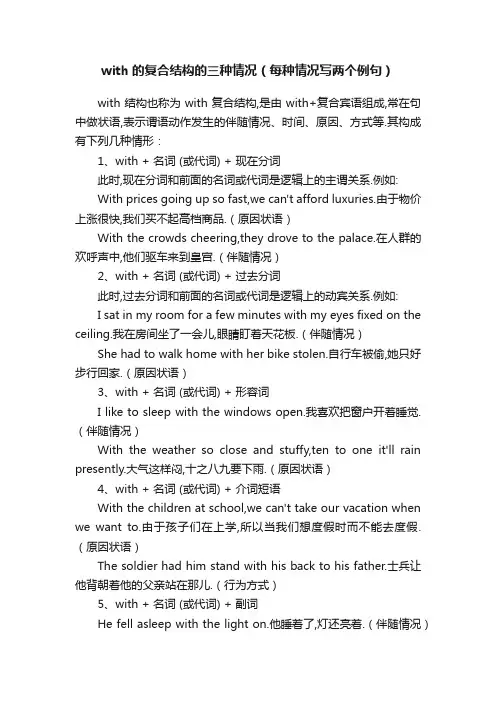
with的复合结构的三种情况(每种情况写两个例句)with结构也称为with复合结构,是由with+复合宾语组成,常在句中做状语,表示谓语动作发生的伴随情况、时间、原因、方式等.其构成有下列几种情形:1、with + 名词 (或代词) + 现在分词此时,现在分词和前面的名词或代词是逻辑上的主谓关系.例如:With prices going up so fast,we can't afford luxuries.由于物价上涨很快,我们买不起高档商品.(原因状语)With the crowds cheering,they drove to the palace.在人群的欢呼声中,他们驱车来到皇宫.(伴随情况)2、with + 名词 (或代词) + 过去分词此时,过去分词和前面的名词或代词是逻辑上的动宾关系.例如:I sat in my room for a few minutes with my eyes fixed on the ceiling.我在房间坐了一会儿,眼睛盯着天花板.(伴随情况)She had to walk home with her bike stolen.自行车被偷,她只好步行回家.(原因状语)3、with + 名词 (或代词) + 形容词I like to sleep with the windows open.我喜欢把窗户开着睡觉.(伴随情况)With the weather so close and stuffy,ten to one it'll rain presently.大气这样闷,十之八九要下雨.(原因状语)4、with + 名词 (或代词) + 介词短语With the children at school,we can't take our vacation when we want to.由于孩子们在上学,所以当我们想度假时而不能去度假.(原因状语)The soldier had him stand with his back to his father.士兵让他背朝着他的父亲站在那儿.(行为方式)5、with + 名词 (或代词) + 副词He fell asleep with the light on.他睡着了,灯还亮着.(伴随情况)The boy stood there with his head down.这个男孩低头站在那儿.(伴随情况)6 、with + 名词 (或代词) + 动词不定式此时,不定式表示将发生的动作.例如:With no one to talk to,John felt miserable.由于没人可以说话的人,约翰感到很悲哀.(原因状语)With a lot of work to do,he wasn't allowed to go out.因为还有很多工作要做,他没有被允许外出.(原因状语)。


With复合结构with结构是许多英语复合结构中最常用的一种。
形式非常灵活,表达的意思也多种多样,在单选、完形中经常出现,且写作文时是很好的加分表达方式。
with结构的构成它是由介词with或without+复合结构构成,复合结构作介词with或without的复合宾语,复合宾语中第一部分宾语由名词或代词充当,第二部分补足语由形容词、副词、介词短语、动词不定式或分词充当,分词可以是现在分词,也可以是过去分词。
With结构构成方式如下:with或without-名词/代词+形容词例句:He is used to sleeping with the windows open.with或without-名词/代词+副词例句:She left the room with all the lights on.with或without-名词/代词+介词短语例句:He walked into the dark street with a stick in his hand.with或without-名词/代词 +动词不定式例句:With so much work to do, I have no time for a holiday.with或without-名词/代词 +分词例句:We found the house easily with the little boy leading the way.(现在分词表示主动动作,即分词所表示的动作是由with后的宾语发出来的) With all the things she needed bought, she went home happily.(过去分词表示被动,with后面的宾语与过去分词之间是被动关系)without+名词/代词+补语例句:Possibly this person died without anyone knowing where the coins were hidden.He wondered if he could slide out of the lecture hall without anyone noticing (him).with the winter is comingwith+不定式和+分词的区别加不定式是指将要进行的动作,加分词是指主动或被动动作.with复合结构的句法功能with 复合结构,在句中表状态或说明背景情况该结构常做伴随、方式、原因、条件等状语。
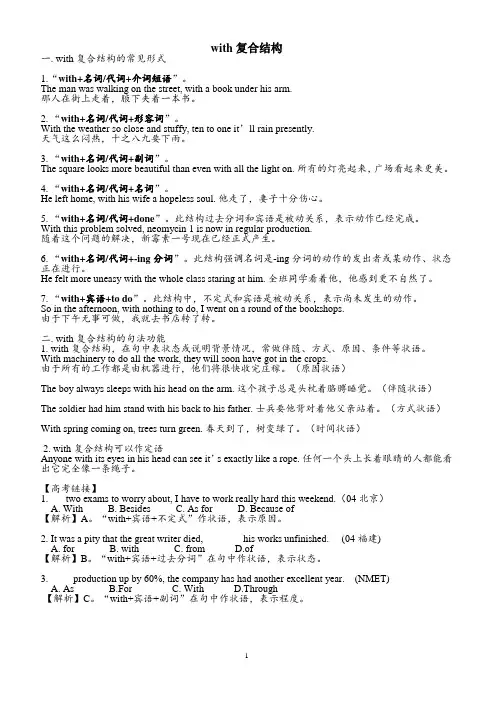
with复合结构一. with复合结构的常见形式1.“with+名词/代词+介词短语”。
The man was walking on the street, with a book under his arm.那人在街上走着,腋下夹着一本书。
2. “with+名词/代词+形容词”。
With the weather so close and stuffy, ten to one it’ll rain presently.天气这么闷热,十之八九要下雨。
3. “with+名词/代词+副词”。
The square looks more beautiful than even with all the light on. 所有的灯亮起来,广场看起来更美。
4. “with+名词/代词+名词”。
He left home, with his wife a hopeless soul. 他走了,妻子十分伤心。
5. “with+名词/代词+done”。
此结构过去分词和宾语是被动关系,表示动作已经完成。
With this problem solved, neomycin 1 is now in regular production.随着这个问题的解决,新霉素一号现在已经正式产生。
6. “with+名词/代词+-ing分词”。
此结构强调名词是-ing分词的动作的发出者或某动作、状态正在进行。
He felt more uneasy with the whole class staring at him. 全班同学看着他,他感到更不自然了。
7. “with+宾语+to do”。
此结构中,不定式和宾语是被动关系,表示尚未发生的动作。
So in the afternoon, with nothing to do, I went on a round of the bookshops.由于下午无事可做,我就去书店转了转。
二. with复合结构的句法功能1. with 复合结构,在句中表状态或说明背景情况,常做伴随、方式、原因、条件等状语。
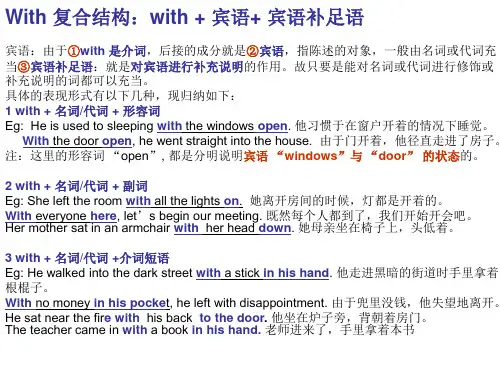
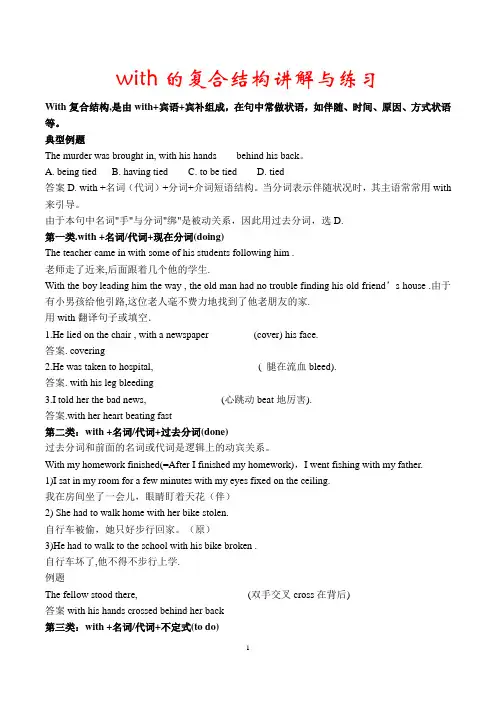
with的复合结构讲解与练习With复合结构,是由with+宾语+宾补组成,在句中常做状语,如伴随、时间、原因、方式状语等。
典型例题The murder was brought in, with his hands ___ behind his back。
A. being tiedB. having tiedC. to be tiedD. tied答案D. with +名词(代词)+分词+介词短语结构。
当分词表示伴随状况时,其主语常常用with 来引导。
由于本句中名词"手"与分词"绑"是被动关系,因此用过去分词,选D.第一类.with +名词/代词+现在分词(doing)The teacher came in with some of his students following him .老师走了近来,后面跟着几个他的学生.With the boy leading him the way , the old man had no trouble finding his old friend’s house .由于有小男孩给他引路,这位老人毫不费力地找到了他老朋友的家.用with翻译句子或填空.1.He lied on the chair , with a newspaper ________ (cover) his face.答案. covering2.He was taken to hospital, ____________________ ( 腿在流血bleed).答案. with his leg bleeding3.I told her the bad news, ______________ (心跳动beat地厉害).答案.with her heart beating fast第二类:with +名词/代词+过去分词(done)过去分词和前面的名词或代词是逻辑上的动宾关系。
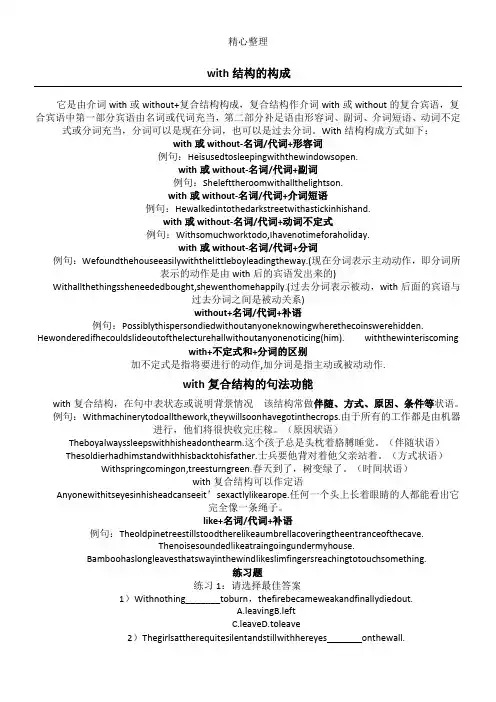
精心整理with结构的构成它是由介词with或without+复合结构构成,复合结构作介词with或without的复合宾语,复合宾语中第一部分宾语由名词或代词充当,第二部分补足语由形容词、副词、介词短语、动词不定式或分词充当,分词可以是现在分词,也可以是过去分词。
With结构构成方式如下:with或without-名词/代词+形容词例句:Heisusedtosleepingwiththewindowsopen.with或without-名词/代词+副词例句:Shelefttheroomwithallthelightson.with状语。
例句:全像一条绳子。
like+名词/代词+补语例句:Theoldpinetreestillstoodtherelikeaumbrellacoveringtheentranceofthecave.Thenoisesoundedlikeatraingoingundermyhouse.Bamboohaslongleavesthatswayinthewindlikeslimfingersreachingtotouchsomething.练习题练习1:请选择最佳答案1)Withnothing_______toburn,thefirebecameweakandfinallydiedout.A.leavingB.leftC.leaveD.toleave2)Thegirlsattherequitesilentandstillwithhereyes_______onthewall.A.fixingB.fixedC.tobefixingD.tobefixed3)Iliveinthehousewithitsdoor_________tothesouth.(这里with结构作定语)A.facingB.facesC.facedD.beingfaced4)Theypretendedtobeworkinghardallnightwiththeirlights____.A.burnB.burntC.burningD.toburn练习2:用with复合结构完成下列句子1)_______________________________(有很多工作要做),Icouldn'tgotoseethedoctor.) ----Sorry.Withsomuchwork_______mymind,Ialmostbreakdown.(2007福建)A.filledB.fillingC.tofillD.beingfilled5.Johnreceivedaninvitationtodinner,andwithhiswork______,hegladlyacceptedit.(2007安徽)A.finishedB.finishingC.havingfinishedD.wasfinished6.Icouldn’tdomyhomeworkwithallthatnoise_______.(2005北京)A.goingonB.goesonC.wentonD.togoon7._______andnowaytoreduceherpainandsufferingfromtheterribledisease,thepatientsoughtherdoctor’shelptoendherlife.(2005江西)A.HavinggivenuphopeofcureB.WithnohopeforcureC.TherebeinghopeforcureD.Inthehopeofcure8.________twoexamstoworryabout,Ihavetoworkreallyhardthisweekend.(2004北京)A.WithB.BesidesC.AsforD/Becauseof9.Itwasapitythatthegreatwriterdied_______hisworksunfinished.(2004福建)A.forB.withC.fromD.of10.______productionupby60%,thecompanyhashadanotherexcellentyear.(2000全国卷)A.AsB.ForC.WithD.Through12)意思,3)答案是A.face“朝、向”,是不及物动词,所以和itsdoor是主动关系,所以用现在分词形式。
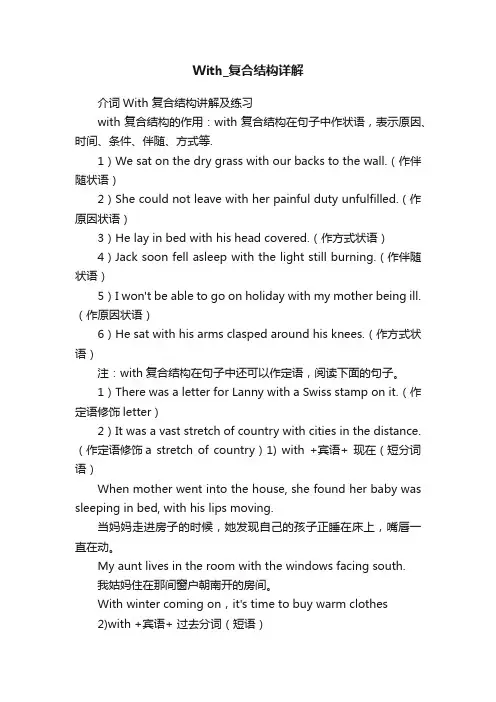
With_复合结构详解介词With 复合结构讲解及练习with复合结构的作用:with复合结构在句子中作状语,表示原因、时间、条件、伴随、方式等.1)We sat on the dry grass with our backs to the wall.(作伴随状语)2)She could not leave with her painful duty unfulfilled.(作原因状语)3)He lay in bed with his head covered.(作方式状语)4)Jack soon fell asleep with the light still burning.(作伴随状语)5)I won't be able to go on holiday with my mother being ill.(作原因状语)6)He sat with his arms clasped around his knees.(作方式状语)注:with复合结构在句子中还可以作定语,阅读下面的句子。
1)There was a letter for Lanny with a Swiss stamp on it.(作定语修饰letter)2)It was a vast stretch of country with cities in the distance.(作定语修饰a stretch of country)1) with +宾语+ 现在(短分词语)When mother went into the house, she found her baby was sleeping in bed, with his lips moving.当妈妈走进房子的时候,她发现自己的孩子正睡在床上,嘴唇一直在动。
My aunt lives in the room with the windows facing south.我姑妈住在那间窗户朝南开的房间。
With的复合结构With复合结构,是由with+宾语+宾补组成,在句中常做状语,如伴随、时间、原因、方式状语等,也可以做定语。
1.with+名词(或代词)+名词there is a tallng am “B s H s ”.B g s a s r.他们住在北京,他们的儿子是个士兵。
2) He died s a a s -girl.他去逝时,女儿还是个小学生。
3) He lived a rich life, s a a a .他过着富足的生活,而他的老父亲却沿街乞讨。
2.with+名词(或代词)+形容词强调名词的特性或状态She came into the room,with her nose red a s e of cold.1s open.我喜欢把窗户开着睡觉。
(伴)2) D ’ a with your mouth full.嘴里有食物时不要讲话。
(伴)3.with+名词(或代词)+副词With the meal over ,we all went home.a with the light on.他睡着了,灯还亮着。
(伴)2) The boy stood there with his head down.这个男孩低头站在那儿。
(伴)4.with+名词(或代词)+介词短语Do you know the woman with a baby in her arms(=who has ababy in her arms)?a a a a a on when we want to.由于孩子们在上学,所以当我们想度假时而不能去度假。
(原)a a a a .士兵让他背朝着他的父亲站在那儿。
(方)5.with+名词(或代词)+动词不定式此时,不定式表示将发生的动作。
With the boy to lead the way,we will find the house easm ow.1) With no one to talk to, John felt upset.由于没人可以说话的人,约翰感到很焦虑。
1 With 的复合结构(with+ 复合宾语)with+ 复合宾语结构常作原因状语、伴随状语、定语等。
With + 名词/代词+名词With + 名词/代词+形容词With + 名词/代词+副词With + 名词/代词+介词短语With + 名词/代词+不定式(to do/ to be done 表示动作将要做, 若句中主语发出动作,用to do , 若句中主语不发出这一动作,则用to be doneWith + 名词/代词+现在分词(doing/ being done 表示动作与谓语动词同时进行,若是with 后的名词/代词发出动作,即所谓的主动,则用doing ; 若是被动,则用being done )With + 名词/代词+过去分词(动作已结束,动词与前面名词/代词的关系是被动) He left home, with his wife a hopeless soul.She used to sleep with the windows open.She used to sleep with the light on.She came in, with a book in her hand.With all the work to do, I don’t know if I’ll have time to go out.With the boy leading us, we soon found the house.With the house being painted, we can’t move in.With everything I needed bought, I left the shop.2 独立主格结构一般来说,我们把With 复合结构中的with 去掉,就成了独立主格结构了。
如:She slept, the windows open.The prisoner stood there, his hands raised. ( 可以这样理解:hand 是被举起的,表示被动和完成)Time permitting, We ‘ll go for a picnic.(time和permit 是主动关系)She came in, book in hand. (注: book 和hand 之前不加任何代词或冠词,这与with 复合结构不同)还有不同的是,独立主格中出现了beingIt being a fine day, we decided to go swimming.There being no bus, I had to go home on foot.这两句话中的being 是由动词be 变来的,可以这样想:独立主格也是状语,所以不能使用谓语动词。
with的复合结构用法及例句With复合结构是由介词with或without+复合结构构成,复合结构作介词with或without的复合宾语,复合宾语中第一部分宾语由名词或代词充当,第二部分补足语由形容词、副词、介词短语或非谓语动词充当。
with的六种用法含例句:1.表示方式、手段或工具等时(=以,用),如:with a car 用卡车2. 与某些抽象名词连用时,其作用相当于一个副词.如:with care=carefully 认真地with kindness=kindly 亲切地3. 表示条件时,根据情况可与虚拟语气连用.如:With more money I would be able to buy it. 要是钱多一点,我就买得起了.With better equipment, we could have finished the job even sooner. 要是设备好些,我们完成这项工作还要快些.4. 比较with和as:两者均可表示“随着”,但前者是介词,后接名词或代词;后者是连词,用于引导一个句子.比较:He will improve as he grows older. 随着年龄的增长,他会进步的.People’s ideas change with the change of the times. 时代变了,人们的观念也会变化.5. 复合结构“with+宾语+宾语补足语”是一个很有用的结构,它在句中主要用作状语,表示伴随、原因、时间、条件、方式等;其中的宾语补足语可以是名词、形容词、副词、现在分词、过去分词、不定式、介词短语等.如:(1) with+宾语+形容词He often sleeps with the windows open. 他常开着窗睡觉.Don’t speak with your mouth full. 不要满嘴巴食物说话.(2) with+宾语+ 副词He stood before his teacher with his head down. 他低着头站在老师面前.He was lying on the bed with all his clothes on. 他和衣躺在床上.(3) with +宾语+ 介词短语She said good-bye with tears in her eyes. 她含着眼泪说了声再见.The man was asleep with his head on his arms. 这个人头枕着胳膊睡着了.(4) with+宾语+现在分词He fell asleep with the lamp burning. 他没熄灯就睡着了.I won’t be able to go on holiday with my mother being ill. 因为妈妈有病, 我无法去度假.(5) with +宾语+ 过去分词He sat there with his eyes closed. 他闭目坐在那儿.All the afternoon he worked with the door locked. 整个下午他都锁着门在房里工作.(6) with +宾语+ 动词不定式I can’t go out with all these clothes to wash. 要洗这些衣服, 我无法出去了.With such good cadres to carry out the Party’s policy we feel safe. 有这样的好干部执行党的'政策, 我们感到放心.(7) with +宾语+ 名词He died with his daughter yet a schoolgirl. 他去世时,女儿还是个小学生.With复合结构:一、with或without+名词/代词+形容词例句:1.I like to sleep with the windows open.我喜欢把窗户开着睡觉。
with的复合结构用法及例句"with"是一个介词,表示伴随、具有、使用等意思。
在使用中,"with"通常与名词、动名词或现在分词形式连用,构成复合结构。
以下是使用"with"的一些常见用法及相应的例句:1.与人/物伴随:- I went to the beach with my friends.(我和我的朋友一起去了海滩。
)- She always carries a notebook with her.(她总是随身带着一个笔记本。
)2.具备其中一种特征/性质:- She is a talented musician with perfect pitch.(她是一个具有绝对音感的有才华的音乐家。
)- The cake was delicious, with a rich chocolate flavor.(这个蛋糕很美味,有浓郁的巧克力味。
)3.通过其中一种方式/方法/工具:- He signed the document with a pen.(他用钢笔签署了文件。
)- She unlocked the door with a key.(她用一把钥匙打开了门。
)4.执行其中一种行为:- She greeted him with a warm smile.(她用热情的微笑向他打招呼。
)- They cheered with excitement when their team won.(当他们的团队获胜时,他们兴奋地欢呼起来。
)5.具有或浸润于其中一种状态/情感:- She looked at him with suspicion.(她带着怀疑地看着他。
)- He slept with a peaceful expression.(他睡得安详。
)需要注意的是,"with"后面的名词或动名词在复合结构中起到一种补充说明、限制或修饰的作用。
with结构的构成它是由介词with或without+复合结构构成,复合结构作介词with或without的复合宾语,复合宾语中第一部分宾语由名词或代词充当,第二部分补足语由形容词、副词、介词短语、动词不定式或分词充当,分词可以是现在分词,也可以是过去分词。
With结构构成方式如下:with或without-名词/代词+形容词例句:He is used to sleeping with the windows open.with或without-名词/代词+副词例句:She left the room with all the lights on.with或without-名词/代词+介词短语例句:He walked into the dark street with a stick in his hand.with或without-名词/代词+动词不定式例句:With so much work to do, I have no time for a holiday.with或without-名词/代词+分词例句:We found the house easily with the little boy leading the way.(现在分词表示主动动作,即分词所表示的动作是由with后的宾语发出来的)With all the things she needed bought, she went home happily.(过去分词表示被动,with后面的宾语与过去分词之间是被动关系)without+名词/代词+补语例句:Possibly this person died without anyone knowing where the coins were hidden. He wondered if he could slide out of the lecture hall without anyone noticing (him). with the winter is comingwith+不定式和+分词的区别加不定式是指将要进行的动作,加分词是指主动或被动动作.with复合结构的句法功能with 复合结构,在句中表状态或说明背景情况该结构常做伴随、方式、原因、条件等状语。
with结构的构成欧阳歌谷(2021.02.01)它是由介词with或without+复合结构构成,复合结构作介词with或without的复合宾语,复合宾语中第一部分宾语由名词或代词充当,第二部分补足语由形容词、副词、介词短语、动词不定式或分词充当,分词可以是现在分词,也可以是过去分词。
With 结构构成方式如下:with或without-名词/代词+形容词例句:He is used to sleeping with the windows open.with或without-名词/代词+副词例句:She left the room with all the lights on.with或without-名词/代词+介词短语例句:He walked into the dark street with a stick in his hand. with或without-名词/代词 +动词不定式例句:With so much work to do, I have no time for a holiday. with或without-名词/代词 +分词例句:We found the house easily with the little boy leading the way.(现在分词表示主动动作,即分词所表示的动作是由with后的宾语发出来的)With all the things she needed bought, she went home happily.(过去分词表示被动,with后面的宾语与过去分词之间是被动关系) without+名词/代词+补语例句:Possibly this person died without anyone knowing where the coins were hidden. He wondered if he could slide out of the lecture hall without anyone noticing (him). with the winter is comingwith+不定式和+分词的区别加不定式是指将要进行的动作,加分词是指主动或被动动作. with复合结构的句法功能with 复合结构,在句中表状态或说明背景情况该结构常做伴随、方式、原因、条件等状语。